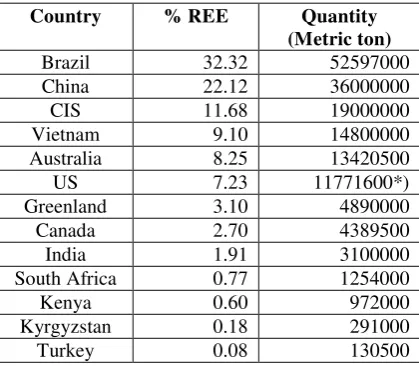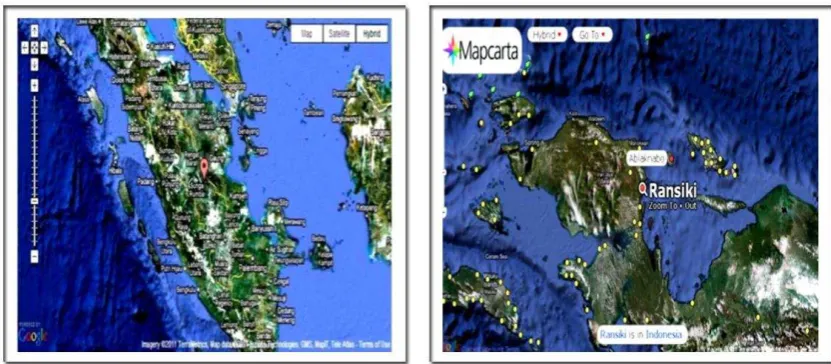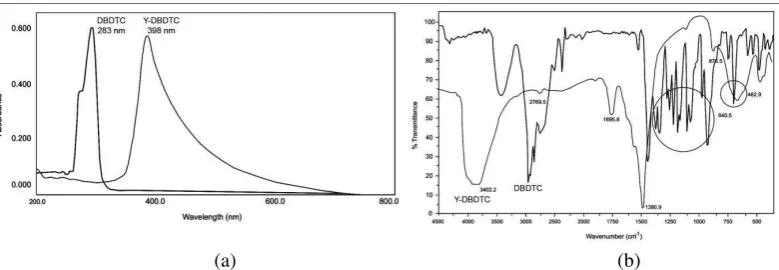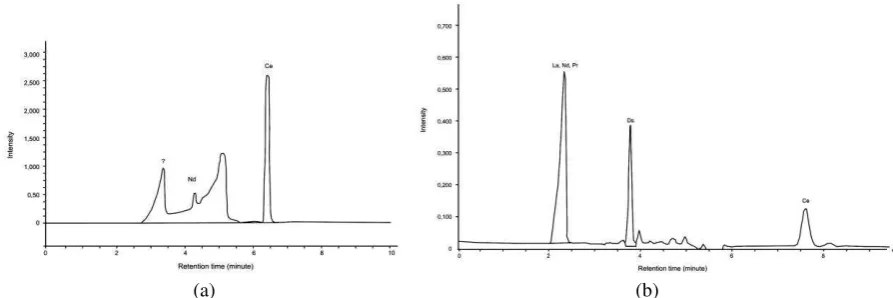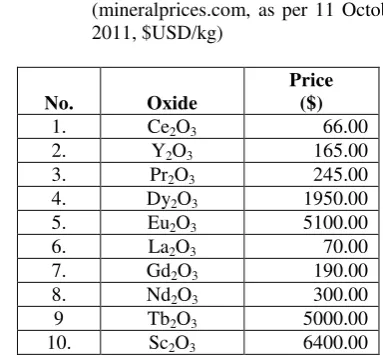Husein H. Bahti et al. 421
Extraction and chromatographic studies on rare-earth elements (REEs)
from their minerals: the prospect of REEs production in Indonesia?
Husein H. Bahti*, Yayah Mulyasih, Anni Anggraeni
Department of Chemistry, Faculty of Mathematics and Natural Sciences, Universitas Padjadjaran Jalan Raya Bandung-Sumedang Km. 19, Jatinangor, Indonesia
*Corresponding author: [email protected]
Abstract
Rare-earth elements, which are important materials in numerous high technology applications, are relatively abundant in Indonesia, but have not been exploited for optimal economic benefit. One of
our research group’s objectives of the studies on REEs is to develop extraction and chromatographic method(s) to prepare both mixture of REEs (or concentrates) and single rare-earth elements with sufficient purity, using di-n-butyldithiocarbamic (DBDTC) and with di-n-butyldithiophosphoric (DBDTP) acids as chelate-forming ligands. The complex formation reaction between each element under investigation (i.e. the rare-earth elements commonly constituting the minerals monazite and xenotime: Nd, Y, Ce, La, Gd) and each of the acidic ligands was studied for the first time. To prepare REEs concentrates, REE mineral samples were digested with different oxidizing reagents and experimental conditions. In one of the procedures, a mineral sample was digested with sulphuric acid, to produce REEs in their ionic forms, which were then separated from both insoluble and soluble non REEs. The resulted REEs were precipitated from their solution as oxalates, which were converted into hydroxides. The REE hydroxides were then calcinated to result in REE oxides. Using DBDTC, five out of the six elements contained in the studied minerals could be extracted at a pH range of 2.0 - 7.0, with non polar organic solvents, resulting in extraction efficiencies ranging from 58-79%. During the extraction of the elements with DBDTP at a pH of 2.0, higher extraction efficiencies (80 to almost 100%) were resulted. Separation of Ce, Y, and Gd as single elements from the REEs mixture using the ligands at selected experimental conditions has been shown to be possible. Chromatographic separation of a mixture of Nd, Pr, Ce, and La as their complexes with DBDTC on a C18 column, with mobile phases of methanol-acetonitrile mixtures has been successful. Meanwhile, Ce has been well separated from its mixture with the other rare-earth elements in a monazite sample as its complex with DBDTP on the same column, using the same mobile phase system. Separation of rare earth elements on ion exchange chromatographic columns, including those prepared from cellulose fibers isolated from local banana stems, have been studied. The resulted separation method(s) are recommended for their adoption and further development to become the technology for the production of rare-earth elements of required purity for commercial purposes. But the idea of producing the REEs products must be aided by the business through co-operation, and supported or pushed by the government through its policy and regulations on the management of natural resources.
Keywords: Rare-earth elements, extraction, chromatography, butyldithiocarbamic acid, di-n-butyldithio-phosphoric acid.
I
ntroductionDescription of Rare-Earth Elements (REEs)
Rare-earth elements consist of 17 elements i.e. lanthanum (La), cerium (Ce), praseodymium (Pr), neodymium (Nd), promethium (Pr), samarium (Sm), europium (Eu), gadolinium (Gd), terbium (Tb), dysprosium (Dy), holmium (Ho), erbium (Er), thulium (Tm), ytterbium (Yb), lutetium (Lu), scandium (Sc), and yttrium (Y) (Prayitno, 2005). In spite of their given name, rare-earth elements, excepting promethium, are actually relatively abundant in the earth's crust. Indeed, cerium for instance is among the most abundant elements. It’s a pity however, due to their geochemical properties,
rare-earth elements are typically dispersed and rarely found in concentrated and economically exploitable forms, known as rare earth minerals (Mulyasih, 2009).
The Uses of REEs
Husein H. Bahti et al. 422
strong and light alloys, wave tubes, neutron reflectors, and other devices that keep us safe and make life easier. Moreover, one of the other uses of rare earth metals is the energy industry. Aside from their crucial role in batteries, rare earths are also being tested for use as nuclear fuel, or at least as nuclear fuel additive.
Based on the above-mentioned facts it is not surprising that the demand for these metals has become increased Jufrizal (2005).
Global Distribution of REEs
REE resources are found in all the continents in the world (see Figure 1a, b) (chinarareearths.net).
The continents are Europe, Asia, Africa, America, Latin America, and Australia, although the number of locations are not evenly distributed among the continents, and of course the same is true for the abundance of REE in each location. It will be pointed out that the distribution will change as exploration activities develop.
According to quantitative data on the total REE distribution 2010 released by USGS, CSRE and Roskill (see Figure 1b and Table 1) the first rank is taken by Brazil (32.32%), which is followed by China (22.12%), CIS (11.68%),Vietnam (9.1%), Australia (8.25%), and the US (7.25%).
(a) (b)
Figure 1 (a) The distribution map of global rare earth resources; (b) Total REEs distribution 2010.
Table 1 Total REEs distribution 2010.
Country % REE Quantity
(Metric ton)
Brazil 32.32 52597000 China 22.12 36000000 CIS 11.68 19000000 Vietnam 9.10 14800000 Australia 8.25 13420500 US 7.23 11771600*) Greenland 3.10 4890000 Canada 2.70 4389500 India 1.91 3100000 South Africa 0.77 1254000 Kenya 0.60 972000 Kyrgyzstan 0.18 291000 Turkey 0.08 130500
Notes:
-
*) 13 million metric tons (http://en.wikipedia.org/wiki/Rare_earth_element)Husein H. Bahti et al. 423 Figure 2 (a) Maps of Sumatra island, Riau Archipelago, Bangka and Belitung islands and (b) map of Ransiki,
West Papua; where REE deposits are found.
Table 2 Locations of REE source in Indonesia
No. Location of REE Source
1. Karimun 2. Kuala Kampar 3. Bangkinang (Riau) 4. PegununganTiga Puluh 5. Singkep
6. Bangka 7. Belitung 8. Sumatra
9. Rirang, West Kalimantan (along with uranium deposits) 10. East Kalimantan (along with gold deposits)
11. Sulawesi
12. Sula-Banggai islands 13. Ransiki (Papua)
REEs Deposits in Indonesia
Table 1 shows that Indonesia is not on the list. But it was reportedthat the country has a significant amount of REE minerals (Suprapto, 2009). In fact, REE deposits (along with tin minerals) span from Karimun (Riau) down to Bangka and Belitung islands, to form what so called “The tin lane” (see Figure 2).
The presence of REE in Bangka and Belitung islands along with tin mining is kwon very well. Table 2 contains list of places in Indonesia where REEs are found, to include Kalimantan (along with gold deposits), Rirang (West Kalimantan, along with uranium deposits), Sulawesi, Sula-Banggai islands (a group of small islands located between Sulawesi and Papua), and Ransiki (in the east part of the Bird Head of Papua).
Rare earth minerals in Indonesia are resulted from alluvial tin and gold deposits. Alluvial gold deposits are relatively abundant and found in major
islands in Indonesia such as Kalimantan, while the
world’s tin lane encompasses Indonesia territory,
starting from Karimun, Singkep to Bangka Belitung. Tin deposits are also found in Sumatra, Kampar, and Bangkinang, Riau. In view of the gold and tin potential in Indonesia, the country has greater opportunity to give added values of associated mineral in the form of rare earth. Rare earth deposits are also found along with uranium deposits, such as in Rirang, West Kalimantan.
The mineral mostly found in nature are bastnaesite, monazite, xenotime, zircon and apatite (http://id.wikipedia.org/wiki/logam_tanah_jarang).
According to the data at the Geology Resource Center in 2007, the total monazite ore deposits in Indonesia are 185,992 tons (Suprapto, 2009).
Research Objectives
Husein H. Bahti et al. 424
single elements with sufficient purity, at laboratory and/or preparative scales. The ultimate objectives are of course to have the methods adopted for the basic of the technology for the production of pure commercial REEs, and to give added values to REE minerals.
Extraction of REEs from their minerals
Digestion of REE minerals and Preparation of REE oxides
Methods for producing REEs from their minerals have been known for a quite long time, and basically are simple, and have been used as the technology in countries like China, the US and India. The first step in the production of REEs is to release them from their linkages as complex compounds through decomposition of the minerals by fusing with such a reagent as Na2O2 or Na2CO3
or by employing wet decomposition with concentrated strong mineral acids, such as sulphuric acid or nitric acid. By decomposing the minerals the REEs are converted into their ionic forms, which are then separated from non REEs materials. Improvements to the decomposition procedures in order to improve efficiency and yield have been done by many researchers.
In our studies (Ruslin, 2004), REE mineral samples were digested with different oxidizing reagents and experimental conditions, with increased quantity of sample up to kilo gram scale. In one of the procedures, a mineral sample (10 g – 1 kg; 100 or 150 mesh) was digested with 18 M sulphuric acid at 110-250°C, to produce REEs in their ionic forms, which were soluble in the concentrated acid. The REEs were separated from insoluble (and refractory) non-REEs, converted into trivalent cations by reacting with hydrogen peroxide, precipitated as REE hydroxides using ammonium hydroxide. The gelatinous hydroxides were filtered and re-dissolved in hydrochloric acid solution. REEs were separated from non REE metal ions by masking the latter with tartaric acid, while precipitation of the REEs as oxalates. The REE oxalates were then converted back into hydroxides, and the hydroxides were calcinated at 1000°C for 2 hours to result in REE oxides.
The SEM data of monazite sample collected from Bangka are presented in Table 3.
The data show that the main REE elements of the monazite sample were cerium, lanthanum, and neodymium. Meanwhile, the SEM data of the resulted REE oxides show that the process of digestion and pre-purification has increased the percentage content of the main elements in the product. Based on a simple calculation, the REE oxide product has a purity of about 76%.
Using similar procedure, the SEM data of xenotime sample collected from Bangka are presented in Table 4.
Table 3 SEM analytical data of monazite sample collected from Bangka Island
Table 4 SEM analytical data of xenotime sample collected from Bangka Island
Table 4 show that samples of xenotime contains Ce, Nd, Gd, and Eu. Meanwhile the SEM data of the resulted REE oxide contains 4 major components: Y, Ce, La, and Gd (Warsito & Biyantoro) Xenotime: Y, 46.7947; La, 4.3314; Ce, 5.1204; Nd, 2.2474; Sm, 0.9547; Gd, 0.1166; Dy, 0.0772). Based on calculation, the REE oxides has a purity of about 70%.
A conclusion that can be drawn from digestion experiments together with a few simple pre-separation procedures is that REE oxide products from both monazite and xenotime samples collected from Bangka island still need further purification by such other methods as extraction and chromatography.
Liquid-liquid Extraction of REEs
Husein H. Bahti et al. 425
difficult, particularly because of the similarity of their physical and chemical properties.
Previous methods of liquid-liquid extraction of rare earth elements from their minerals and subsequent separation and purification into single elements have been developed and improvements to the methods have also been done. Different ligands such as di-2,4,4-trimethylpentyl phosphinic acid (DTMPPA), di-(2-ethylhexyl phosphoric acid (D2EHPA), andtributylphosphate (TBP) have been
used for the extraction of REEs (Khaldun, 2009). In our studies (Mulyasih, 2009) the use of dibutyldithiocarbamic acid (DBDTC) and dibutyldithio-phosphoric acid (DBDTP) have been examined for the extraction of the elements.
Complex formation reaction
For the purpose of studying liquid-liquid extraction (and chromatography) of rare-earth elements as their complexes with DBDTC and with DBDTP, the complex formation reaction between each element under investigation (Nd, Y, Ce, La, Gd) and each acidic ligand was firstly studied.
To give the idea about this particular study, a solution of yttrium (III) was reacted with a solution of dibutyldithiocarbamic acid. The reaction product (which was a white solid and soluble in a non polar organic solvent) was characterized using UV, IR, and mass spectrometry.
Figure 3a shows that the purified reaction product has different UV spectra from that of the ligand, and has different maximum absorption. The reaction product has UV absorption at 283 nm (n
π* from free electron at S atom), while the ligand has UV absorption at 398 nm). Formation of Y(III)-DBDTC complex was indicated by the
disappearance of π π* transition from C= S,
which resulted in the breakdown of the C = C bond and the resonance of electrons in the chelate ring.
The infrared spectra of the purified reaction products (Figure 3b) was also different from that of the ligand, both in the functional group and in the finger print regions. A peak of DBDTC spectrum at 3444-3115 cm-1 (N-H stretching of ammonium) print region of the spectra of the resulted compound showed different pattern with that of the corresponding ligand.
MS spectra of the Y complex (Figure 4) show a molecular ion peak (M-H) at m/z 701, corresponds to the calculated MW of the proposed structure of constituting the mineral monazite) as their complexes with DBDTC and with DBDTP, have been done. Extraction experiments were carried out by using synthetic mixtures of the selected REEs, which were extracted with solutions of the ligands in non-polar organic solvents. The effects of some factors, including ligand concentration, pH, and type of organic solvent, on the extraction efficiency, were studied.
The resulted experimental data show that using DBDTC, five out of the six elements studied, could be extracted, at a pH range 0f 2.0 - 7.0, with petroleum ether or diethyl ether as solvents, with extraction efficiencies ranging from 58-79%. Gadolinium was not extracted at these experimental conditions. Meanwhile, the resulted data on the extraction with DBDTP showed that using this ligand, five out of the six elements investigated could be extracted at a pH of 2.0 with higher extraction efficiencies (80 to almost 100%). Unfortunately, gadolinium was also not extracted. Using the developed methods, REEs has been extracted from xenotime and monazite samples collected from Bangka and Belitung.
(a) (b)
Husein H. Bahti et al. 426 Figure 4 ESI-FT-MS spectra of the reaction product between Y(III) and DBDTC, showing a molecular ion
(M-H) at m/z = 701.
(a) (b)
Figure 5 Ion exchange chromatography of Nd (III), Pr (III), Ce (III), and La (III) on a Supelcosil column: (a) Synthetic mixture, (b) Monazite sample.
Chromatography of REEs
As has been stated above separation of mixtures of REEs into pure single elements is much more difficult task. But chromatography, which is generally accepted as the most powerful separation method for separating many types of compound - organic, inorganic, and biomolecules - has been used to do the task. In fact, separation of REEs into single elements have been done for along time using ion exchange chromatography, and this has been successful in producing REE pure products of individual REE. Ultra-high purity REEs are required to clarify their intrinsic properties and to find a new function material and chromatography is the answer to the need.
Ion exchange chromatography
Some research works on the separation of REEs using ion-exchange chromatography have been done by our research group. Neodymium, praseodymium, cerium, and lanthanum have been separated (Herman, 2006) on the ion exchange HPLC column Supelcosil LC-SCX (25 cm long, 4.6 mm ID, 5 µm particle size) using 1.5 mM ethylene diamine and 2.00 mM tartaric acid as mobile phases. Waters type 432 conductometer was used as detector. The resulted chromatogram is presented on Figure 5.
Husein H. Bahti et al. 427
Separation of REEs into single elements have also been studied by using ion exchange chromatography on ion exchange resin synthesized from the cellulose matrix prepared from local banana stems fibers (Anggraeni, 2009). The resulted constructed chromatograms of the separation of synthetic mixtures of cerium (III) and lanthanum (III) ions on cellulose sulphonate and on
cellulose phosphonate columns using aqueous solution of 1.25 mM ethylene diamine and 1.75 mM tartaric acid at a pH of 4.2 as an eluent, showed that the two rare earth elements were well separated on the cellulose sulphonate column (R = 5.1), and on the cellulose phosphonate column (R = 5.8).
(a) (b)
Figure 6 Ion exchange chromatography of a mixture of Ce (III) and La (III) on the prepared ion exchange resins: (a). cellulose phosphonate (b) cellulose sulphonate.
(a) (b)
Figure 7 Chromatograms of mixtures of REE-DBDTC complexes with mobile phase: (a) 100% acetonitrile. (b) methanol: acetonitrile (50 : 50).
(a) (b)
Husein H. Bahti et al. 428
Reversed phase Chromatography
In our study, reversed-phase chromatography experiments have been done using synthetic mixtures of rare-earth elements commonly found in REE minerals, i.e. neodymium. Promethium, cerium, and lanthanum (Mulyasih, 2009). When good chromatographic system and conditions have been found, then the method was applied to real
mobile phase, and a UV detection system.
As is shown in the chromatograms (Figure 7), the four rare earth elements studied (Nd, Pr, La, and Ce) were well separated from each other (as their DBDTC complexes) and also well separated from the excess ligad (L) and the disulfide (DS), both using 100% acetonitrile and acetonitrile : methanol (50:50) as mobile phases. Disulfide is a side reaction product during the complex formation reaction between a rare-earth element with the ligands.
Figure 8 shows chromatograms of REEs extracted from a monazite sample, as their complexes with DBDTC and DBDTP.
As is shown in each chromatogram, cerium has been well separated from its mixture with the other rare-earth elements in a monazite sample, as its complex with DBDTP on the same column as for synthetic mixtures, using methanol:acetonitrile as the mobile phase. Thus, the method may be used as an alternative method to prepare pure cerium in a preparative scale. Detection of eluates was accomplished using an ultraviolet detector at 210 nm.
REEs production, trade, government policy, and regulations
Before drawing conclusions on the extraction and chromatographic studies, which are ultimately intended for the production of pure REE, it would probably better to have a look at a few other important aspects related to production itself, they are trade, government policy and regulation on the management of natural resources.
China contributes 97% to the global market of REE (Wikipedia.org; Majalah Tambang Online). Rare earth metals have made many industrial countries worry about them for two years now, which makes sense since China began reducing its rare-earth export quotas around the same time. As a consequence during 2009 a very significant amount of REE product was recorded from Brazil, and Malaysia (Suprapto, 2009). But, no contribution
from Indonesia has been made, despite abundance
REEs are not exchange traded in the same way that gold and silver, are. They are sold on the private market, which makes their prices difficult to monitor and track (Wikipedia.org). However, prices are published periodically on websites. To give the idea, the following (Table 5) is a price list of some REE oxides:
Table 5 The price of some REE oxides (mineralprices.com, as per 11 October 2011, $USD/kg)
Note: The price of Monazite sands was Rp.800/kg or $ 0.1 (Khaldun, 2009).
Husein H. Bahti et al. 429
Conclusions and Recommendations
From the above discussions the following conclusions and recommendations can be drawn: 1. Development and improvements in digestion
and separation methods have been done and the resulted methods could be adopted for further development into the technology for up-scaled production of rare-earth elements.
2. Extraction and chromatographic methods have been shown to be prospective for further development as the technology for the preparation of pure rare-earth element products. 3. Rare-earth mineral deposits, which are abundant and spread out of Indonesian archipelagos, must be exploited and processed for optimal economic benefit.
Future Studies
1. Purification of REE mixtures by using extraction method with DBDTP and DBDTC as extractants.
We would like to thank all students, technicians, and the staff members of the Department of Chemistry, Faculty of Mathematics and Natural Sciences, Padjadjaran University, and to all the people who have made contributions and help to our works, during doing the research or preparations for seminar and publications.
References
gadolinium dan ligan di-n-butil ditiofosfat dan dengan asam dietilentriamin penta asetat. Skripsi, Jurusan Kimia, Universitas Padjadjaran.Amin, A. 2001. Pemisahan unsur samarium dan itrium dari mineral tanah jarang dengan
teknik membran cair berpendukung”
(Supported Liquid Membrane). Thesis,
Program Magister, Jurusan Kimia Universitas Padjadjaran.
Anggraeni, A. 2009. Kajian tentang pembuatan resin-resin penukar kation dari selulosa serat pisang, dan tentang penggunaannya untuk pemisahan beberapa unsur tanah jarang secara kromatografi. Disertasi, Program Doktor, Jurusan Kimia Universitas Padjadjaran.
Ayuni, N.P. 2005. Kajian reaksi antara logam serium (III) dan ligan di-n-butilditio-karbamat. Skripsi, Jurusan Kimia, Universitas Padjadjaran .
Bahti, H.H. 2009. Kromatografi sebagai metode pemisahan dan metode analisis: Sekilas tentang pengembangan serta ruang lingkup penggunaannya. Orasi ilmiah, Universitas Padjadjaran.
Budiman, H. 2003. Kromatografi cair kinerja tinggi untuk pemisahan serium dari unsur tanah jarang lainnya dalam monasit melalui pembentukan kompleks dengan di-n-butil
ditiofosfat”, Skripsi, Jurusan Kimia,
Universitas Padjadjaran.
Connelly, N.G., T. Damhus, R.M. Hartshorn & A.T. Hutton (Eds.). 2005. Nomenclature of
Inorganic Chemistry: IUPAC
Recommendations 2005. Cambridge: RSC
Publ. ISBN 0-85404-438-8.ed. (http://www. iupac.org/fileadmin/user_upload/databases/ Red_Book_2005.pdf. Retrieved 2007-12-17.
Framudia, S. 2004. Pemisahan dan penentuan serium hasil olah pasir monasit dan senotim secara kromatografi pertukaran kation lemah. Skripsi, Jurusan Kimia, Universitas Padjadjaran.
Hastuti, S. 2005. Pemisahan unsure tanah jarang dengan teknik membrane berpendukung menggunakan senyawa pembawa dibutilditiofosfat dan dibutilditiokarbamat.
Thesis Program Magister, Jurusan Kimia,
Universitas Padjadjaran.
Herman, 2006. Penentuan kuantitatif Nd, Pr, Ce, dan La dalam monasit dengan KCKT pertukaran ion. Thesis, Program Magister, Jurusan Kimia Universitas Padjadjaran.
Hidayat, Y. 2004. Pemisahan dan penentuan neodimium, praseodimium, serium, dan lanthanum dalam hasil olah pasir monasit dan senotim secara kromatografi cair kinerja tinggi penukar kation kuat. Skripsi, Jurusan Kimia, Universitas Padjadjaran.
Husein H. Bahti et al. 430 Jufrizal, 2005. Pemurnian lanthanum dari monasit
dengan teknik ekstraksi pelarut dan membrane cair berpendukung menggunakan dibutilditiokarbamat dan dibutilditio-fosfat sebagai pengompleks, Thesis, Program Magister, Jurusan Kimia, Universitas Padjadjaran.
Khaldun, I. 2009. Pemisahan unsur logam tanah jarang dari pasir monasit Bangka dengan metode solvent impregnated resin (SIR)”.
Disertasi, Program Doktor, ITB.
MAJALAH TAMBANG ONLINE-NEWSFILES: Rare Earth Mineral
http://www.majalahtambang.com/ detail_berita.php?category=15&new.
Mulyasih, Y. 2009. Ekstraksi dan Kromatografi Cair beberapa unsur tanah jarang sebagai kompleks dengan dibutilditiokarbamat dan dibutilditiofosfat. Disertasi, Program Doktor, Universitas Padjadjaran.
Pratiwi, S.W. 2011. Pembuatan konsentrat unsure tanah jarang dari senotim sebagai hasil samping penambangan timah Bangka.
Skripsi, Jurusan Kimia, Universitas
Padjadjaran.
Prayitno, B.B. 2005. Kajian reaksi antara ion lantanum (III) dan ligan di-n-butil-ditiofosfat. Skripsi, Jurusan Kimia, Universitas Padjadjaran.
Rare Earth Elements-Critical Resources for High Technology U.S. Geological Survey, Fact Sheet 087-02.
Ruslin, 2004. Studi pembentukan senyawa kompleks ion logam tanah jarang (Ce, La, Nd, Pr) dengan ligan di-n-butilditiokarbamat dan di-n-butilditiofosfat. Thesis, Program Magister, Jurusan Kimia, Universitas Padjadjaran.
Saba, A.P.2011. “Rare Earth Mineral, Learning as Far as China”, Tambang, August 26.
Santosa, G.P. 2005. Kajian reaksi antara logam neodymium dan ligan di-n-butil ditiokarbamat. Skripsi. Jurusan Kimia, Universitas Padjadjaran.
Suprapto, S.J. 2009. Tinjauan tentang unsur tanah jarang. Buletin Sumber Daya Geologi.4(1):
36-47.
Warsito, B. & D. Biyantoro. 2009. Optimasi proses pembuatan oksida logam tanah jarang dari pasir senotim dan analisis produk dengan spectrometer pendar sinar-X, Seminar Nasional V, SDM Teknologi Nuklir.
Wilmansyah, T. 2005. Kajian reaksi antara logamitrium (III) dan ligan di-n-butilditio-karbamat. Skripsi, Jurusan Kimia, Universitas Padjadjaran.
http://chinarareearths.net/the-distribution-map-of-global-rare-earth-res.
http://en.wikipedia.org/wiki/Rare_earth_element. http://en.wikipedia.org/wikiRare_earth_element.
Rare earth element, from Wikipedia, the free encyclopedia.
http://id.wikipedia.org/wiki/logam_tanah_jarang. http://www.naturalnews.com/028028_rare_earth_el
